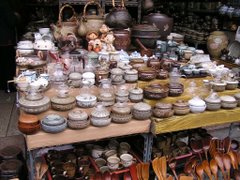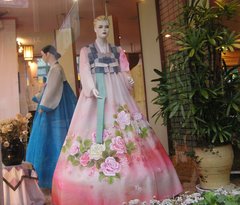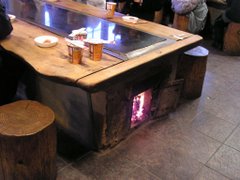More Questions from Teachers
by Dr. Isagani Cruz
http://criticplaywright.blogspot.com/2007/06/more-questions-from-teachers.html
Tuesday, October 23, 2007
Monday, July 09, 2007
Some trivia and keepsakes

Koreans don't like plastic materials. They used this as water disposable cups. :)



If we have chicken Mcdo with rice, they have Bulgogi burgers. :)
In all banks, they always have candies for the clients..
And I used the coins to buy street food -- baked egg, veggie spring roll, nuts with flour wrapping and the spicy seafood balls on long, thick, bbq sticks--very satisfying :)

PNU is a nice university. It's easy to ask directions, the students are accommodating. The people in the bookstore are also hospitable. :)
Tuesday, June 26, 2007
Good Hygiene- a Korean Trademark
When I was in Busan, I was able to observe that the Koreans observe good hygiene. It is a common practice to wash their hands after going to the washroom (or bathroom or toilet whatever name they call it). I personally observed this in the hotel and even in the washroom near our training room within the Main Library of the Pusan National University. Not one Korean female student left the washroom without washing her hands. Even if it is a necessity, not all Asian countries (including the Phils unfortunately) practice this washing of the hands.
Aside from good hygiene, there are other things to learn from the Koreans. They love and patronize their own products. LG and Samsung dominates the electronics and appliance arena. These companies also are the topmost benefactors of the public shools. No wonder the public schools are advanced in school and computer equipment. Hyundai, Sannyong and other Korean manufactured cars are also patronized well. Most of the banks are local Korean banks.
While Korea as a country thinks global, its practices and mindsets are mostly local. The people generally know how to promote, take pride and patronize its own products.
Aside from good hygiene, there are other things to learn from the Koreans. They love and patronize their own products. LG and Samsung dominates the electronics and appliance arena. These companies also are the topmost benefactors of the public shools. No wonder the public schools are advanced in school and computer equipment. Hyundai, Sannyong and other Korean manufactured cars are also patronized well. Most of the banks are local Korean banks.
While Korea as a country thinks global, its practices and mindsets are mostly local. The people generally know how to promote, take pride and patronize its own products.
Monday, May 21, 2007
Lines from Son of Man, sang by Phil Collins
“In learning you will teach
And in teaching you will learn..
Son of man, look to the sky
Lift your spirit, set it free
Some day you’ll walk tall with pride
Son of Man, a man in time you’ll be.”
Son of Man was played and written for the Disney movie Tarzan.
What do you think of this song?
Friday, May 18, 2007
A Perspective from the Guru
The Korean e-Learning Experience From the Eyes of a Filipino Teacher
by Mavic Pineda
Government e-Learning Initiatives
The e-Learning practices of Korea will be very much attributed to strong leadership and existence of national policies[1] geared towards the high utilization and fusion of ICT in all sectors of life in Korea. Policies on e-commerce, e-cluster, e-community, e-Learning collaborative system are few of the recent agenda.
The Ministry of Education is very vital in the current success of Korea’s e-Learning endeavors. While the MOE is getting only around 15% of the national budget, it is able to establish strong partnership with big private companies like Samsung and LG to support the ICT infrastructure needed in schools and state universities. The MOE also takes time to send their teachers to various training outside the country for effective ICT fusion in teaching and learning. [2]
Generally, the e-Learning applications and the learning management systems developed are in Korean language. Presently, MOE is finding ways to translate or convert these programs and other learning materials to English.
Model Schools and Infrastructures
With the broadband internet available in all sectors of the society, e-Learning broadcasting like web casting, video on demand and video-conferencing; and home computing which they call as “cyber home learning service” are the common tools in Korean teaching. Screen casting, holographic simulation and animation tools are also available.
Korea has also established and sustained a dynamic, huge, online teachers’ community in the presence of ALCOB, the APEC Learning Community Builders. This is a good campaign of e-learning practices and a form of empowerment among the teachers. Because of the ALCOB Teacher’s Community, the teachers are able to form their groups, showcase their teaching style, and communicate with teachers around the world.
Below is a table of some of the schools/centers that I visited together with the other participants.

The Busan Information Center may be commended with its model of uniform curriculum and centralized development of lesson materials. I find the development of lessons in forms of video clips to be very effective in several ways. Video clips come very handy because it’s CD based, and consumes short time that allows students to enjoy what is viewed while absorb what is being conveyed in the video. Both teachers and students can easily review the lesson again and again. The language used is in the vernacular which makes it highly understandable.

The Center of Teaching and Learning is an ideal institute. It is able to support teachers and students with interests to improve their learning abilities.

Some Interesting Instructional Techniques
While a lot of teaching strategies and methods were discussed, there were some techniques that caught my attention. Aside from e-mail and chat, the use of videoke to learn a second language is very effective.
Student exhibits and competitions harness the best among the students. Competitions are very common in all the schools. Competitions get the best not only from the students but even from the teachers who coach the students.
Online and/or computerized exams push students to prepare and study well for exams.
The Kimchi Wrap Concept
The kimchi[3] is a staple healthy food in Korea. The kimchi comes in different varieties using different vegetables like raddish, cucumber, turnip and others. The kimchi is commonly served with a bunch of other side dishes, sometimes with bean curd and other vegetables.
What is interesting that most Korean food websites do no tell is the special way of eating kimchi. That is, you get a vegetable leaf, put the kimchi on top, wrap it, and eat it like you place butter inside a dinner roll. Personally, I call this as the kimchi wrap concept. You can replace or mix the kimchi with meat or another side dish suited to your taste, put it on the leaf, and enjoyably eat it.
This is how e-learning is fused in the Korean educational system, it is the same as the Kimchi wrap. While the base food will be kimchi, there will be over a dozen of different ways to eat or relish the kimchi. Education has a high premium in Korea and there are various methods and ways, as well as ICT tools to use to improve teaching and learning.
Not all cities or schools will have excessive funding but the government ensures the schools have uniform curriculum and lesson materials to be used. The structure allows different methods of eliciting creativity and versatility in teaching while students find learning in and outside the school as an inevitable fun and work. And the teachers are empowered, exhibits a lot of confidence.
Conclusion
While my stay in Korea had only been two weeks in November of 2006, the wisdom of the kimchi wrap extends to how the Filipinos can pick up from the Korean practices.
1. The Filipino educational system may want to follow the model of uniform curriculum and lesson materials. The development of video clips can be adopted. Lessons in video are cost-effective and simple to develop than having a courseware made in Flash or a presentation made in Powerpoint. DVD or CD players and televisions are very affordable equipment and are present in leading public schools in the Philippines.
Language used should be in Filipino and not in English. The use of the vernacular language allows students to compose ideas freely and express them without reservations or any form of translation handicap.
2. The Alcob community is a model that the Philippines can also adopt. A Filipino teachers’ community can be a good way to empower teachers across the archipelago and share all their innovative ideas in teaching.
The De La Salle University of the Philippines, the College of Computer Studies as a Center of Excellence in IT, can initiate the formation of an Online Filipino Teachers’ Community that will have the goal of empowering teachers from both the privileged and underprivileged places of the country.
3. While the Filipino local teachers are very dedicated and committed to imparting knowledge to their students, I think the idea of competitions can bring the best out of the students. Both private and public schools should engage in various competitions, inside and outside their own schools. Competition promotes independence, camaraderie, creativity and excellence among students and mentors.
Finally, the vision of shared prosperity of the Apec e-Learning is starting to be realized. It is not only having the chance of having a bird’s eye view of some of the best e-Learning practices of Korea but learning the wisdom from these practices. And as for the kimchi, jal muk ut sup ni da – that was very good.□
[1] The most recent education policy is stated in the National Education Information System 2004. It comprises a timeline of 10 years.
[2] The use of ICT in teaching resulted to very good performance of students in problem-solving, math and reading in high achievement tests conducted in Korea.
[3] The kimchi typically uses soaked, fermented or pickled cabbage with red, ground chili powder and ginger.

The Center of Teaching and Learning is an ideal institute. It is able to support teachers and students with interests to improve their learning abilities.

Some Interesting Instructional Techniques
While a lot of teaching strategies and methods were discussed, there were some techniques that caught my attention. Aside from e-mail and chat, the use of videoke to learn a second language is very effective.
Student exhibits and competitions harness the best among the students. Competitions are very common in all the schools. Competitions get the best not only from the students but even from the teachers who coach the students.
Online and/or computerized exams push students to prepare and study well for exams.
The Kimchi Wrap Concept
The kimchi[3] is a staple healthy food in Korea. The kimchi comes in different varieties using different vegetables like raddish, cucumber, turnip and others. The kimchi is commonly served with a bunch of other side dishes, sometimes with bean curd and other vegetables.
What is interesting that most Korean food websites do no tell is the special way of eating kimchi. That is, you get a vegetable leaf, put the kimchi on top, wrap it, and eat it like you place butter inside a dinner roll. Personally, I call this as the kimchi wrap concept. You can replace or mix the kimchi with meat or another side dish suited to your taste, put it on the leaf, and enjoyably eat it.
This is how e-learning is fused in the Korean educational system, it is the same as the Kimchi wrap. While the base food will be kimchi, there will be over a dozen of different ways to eat or relish the kimchi. Education has a high premium in Korea and there are various methods and ways, as well as ICT tools to use to improve teaching and learning.
Not all cities or schools will have excessive funding but the government ensures the schools have uniform curriculum and lesson materials to be used. The structure allows different methods of eliciting creativity and versatility in teaching while students find learning in and outside the school as an inevitable fun and work. And the teachers are empowered, exhibits a lot of confidence.
Conclusion
While my stay in Korea had only been two weeks in November of 2006, the wisdom of the kimchi wrap extends to how the Filipinos can pick up from the Korean practices.
1. The Filipino educational system may want to follow the model of uniform curriculum and lesson materials. The development of video clips can be adopted. Lessons in video are cost-effective and simple to develop than having a courseware made in Flash or a presentation made in Powerpoint. DVD or CD players and televisions are very affordable equipment and are present in leading public schools in the Philippines.
Language used should be in Filipino and not in English. The use of the vernacular language allows students to compose ideas freely and express them without reservations or any form of translation handicap.
2. The Alcob community is a model that the Philippines can also adopt. A Filipino teachers’ community can be a good way to empower teachers across the archipelago and share all their innovative ideas in teaching.
The De La Salle University of the Philippines, the College of Computer Studies as a Center of Excellence in IT, can initiate the formation of an Online Filipino Teachers’ Community that will have the goal of empowering teachers from both the privileged and underprivileged places of the country.
3. While the Filipino local teachers are very dedicated and committed to imparting knowledge to their students, I think the idea of competitions can bring the best out of the students. Both private and public schools should engage in various competitions, inside and outside their own schools. Competition promotes independence, camaraderie, creativity and excellence among students and mentors.
Finally, the vision of shared prosperity of the Apec e-Learning is starting to be realized. It is not only having the chance of having a bird’s eye view of some of the best e-Learning practices of Korea but learning the wisdom from these practices. And as for the kimchi, jal muk ut sup ni da – that was very good.□
[1] The most recent education policy is stated in the National Education Information System 2004. It comprises a timeline of 10 years.
[2] The use of ICT in teaching resulted to very good performance of students in problem-solving, math and reading in high achievement tests conducted in Korea.
[3] The kimchi typically uses soaked, fermented or pickled cabbage with red, ground chili powder and ginger.
Interesting Technology-based Instructional Tools
Instructional Tools
Web-casting

The Cyberboard, the Big Brother and the Library Kiosk
The Screencasting Tool

The Simulated-visual Tool
The Screencasting Tool

The Simulated-visual Tool

Student Support Tools
post time and date adjusted for presentation purposes
Friday, February 16, 2007
Remembering My Korean Teacher
Dear Ms. Kyung Hee Lee,
The short time you spent with us exhibited the kindness, warmth and hospitality of the Koreans. Special mention are the friends from Giam-hae. We had a good museum visit, a nice car ride and a sumptous dinner. :)

The dinner at your home brought us, your guests from China, Vietnam and Indonesia to become in touch even at far distances. I communicate with Dr. Jia of China, Suri of Indonesia, and LeNgoc Bich of Vietnam. I hope to start communicating with you and your friend, Ms. Jo Mi-Hye.
and LeNgoc Bich of Vietnam. I hope to start communicating with you and your friend, Ms. Jo Mi-Hye.
My shopping spree became convenient with the help of your husband assisting me with the things I'm looking for. I think the Korean stainless chopsticks, coffee stirrer and fruit forks are of the best quality.
And of course, the best part and very unforgettable, a very rejuvinating experience is the jimjibang or the Korean sauna. I also think it's one of the best sauna in the world, very wholesome, very warm and spacious saunas with healthy baked eggs and drinks! Aside from the red ginseng tea, I actually brought home some of those healthy red juices for women. :)
I hope I will have the chance to see Busan again, to see all of you. :)
Thank you for the friendship, the hospitality and the cultural experience.
Cheers,
mavic pineda
Manila, Philippines
The short time you spent with us exhibited the kindness, warmth and hospitality of the Koreans. Special mention are the friends from Giam-hae. We had a good museum visit, a nice car ride and a sumptous dinner. :)

The dinner at your home brought us, your guests from China, Vietnam and Indonesia to become in touch even at far distances. I communicate with Dr. Jia of China, Suri of Indonesia,
 and LeNgoc Bich of Vietnam. I hope to start communicating with you and your friend, Ms. Jo Mi-Hye.
and LeNgoc Bich of Vietnam. I hope to start communicating with you and your friend, Ms. Jo Mi-Hye.
My shopping spree became convenient with the help of your husband assisting me with the things I'm looking for. I think the Korean stainless chopsticks, coffee stirrer and fruit forks are of the best quality.
And of course, the best part and very unforgettable, a very rejuvinating experience is the jimjibang or the Korean sauna. I also think it's one of the best sauna in the world, very wholesome, very warm and spacious saunas with healthy baked eggs and drinks! Aside from the red ginseng tea, I actually brought home some of those healthy red juices for women. :)
I hope I will have the chance to see Busan again, to see all of you. :)
Thank you for the friendship, the hospitality and the cultural experience.
Cheers,
mavic pineda
Manila, Philippines
The Princess of Public Schools: The Dae-shin Elementary School
The Dae-shin Elementary School, a public school in Busan, was made to be an ubiquitous model school. The school has a big campus for a public school, clean and spacious classrooms, and well-designed internet lounge for the students and teachers.

It has a huge cyber board, as big as the usual classroom blackboard. The screen makes it convenient for any teacher to teach. It can change the background-- can become graphical notepad for math subject, a musical note for music or a simple blue-red-blue paper background for teaching hand scripting.

The school also uses smart cards for ID and book borrowing in the library. Students are trained to be independent, self-regulated and honest. Students are free to borrow and return the books in the small library using their IDs to tap in this kiosk.
A health machine is also used to make simple physical health assessments of a person. This is good because you don't need to have a doctor always around. The machine can also finish taking physical make-up of a person at a more efficient speed.

The Big brother system is a must in most schools in South Korea. Bullying incidents are very common. Hence, use of CCTV security cameras are all around. This is something I don't want my child to get accustomed with. It's either a child becomes dependent on sombody watching over him or he is contantly curious whether somebody is watching him while picking his nose.

It has a huge cyber board, as big as the usual classroom blackboard. The screen makes it convenient for any teacher to teach. It can change the background-- can become graphical notepad for math subject, a musical note for music or a simple blue-red-blue paper background for teaching hand scripting.

The school also uses smart cards for ID and book borrowing in the library. Students are trained to be independent, self-regulated and honest. Students are free to borrow and return the books in the small library using their IDs to tap in this kiosk.
A health machine is also used to make simple physical health assessments of a person. This is good because you don't need to have a doctor always around. The machine can also finish taking physical make-up of a person at a more efficient speed.

The Big brother system is a must in most schools in South Korea. Bullying incidents are very common. Hence, use of CCTV security cameras are all around. This is something I don't want my child to get accustomed with. It's either a child becomes dependent on sombody watching over him or he is contantly curious whether somebody is watching him while picking his nose.
Subscribe to:
Posts (Atom)









